Our complete travel packing list, based on personal experience from 6 trips to the polar regions, on what to wear in Antarctica.
Congratulations – you’ve decided to go on one of the world’s most extraordinary adventures in one of the most remote regions on the planet.
This is going to be an experience that will change your life forever, and you’ll be so thankful that you have taken the leap to visit the White Continent.
So now you need to figure out what to pack for Antarctica.
Luckily this needn’t be a stressful or confusing time, and we’ve put together this list of the best Antarctic clothing that will help you on your own expedition.
Even though we travel full-time, living out of our backpacks, we did pick up some specialised clothing for the cold weather in Antarctica that helped make our time there as comfortable as possible.
Now we want to help you with our own packing list for Antarctica.

Table of Contents
- What To Wear In Antarctica
- Our Antarctica Packing List
- Our Best Tip For Cold-Weather Clothing: Layering
- The Most Essential Items to Pack for Antarctica
- Waterproof Boots, Pants and Jackets
- Thermal Underwear
- Comfortable Trousers Or Jeans
- Thermal Socks x 2
- Merino Wool Socks x 3
- T-Shirts x 4
- Long-Sleeve Shirt x 1
- Hooded Jumper x 1
- Down Jacket x 1
- Wind/Rain Jacket x 1 (Optional)
- Glove Liners x 1 Pair
- Ski Gloves x 1 Pair
- Buff Bandana/Neck Gaiter x 2
- Beanie x 1
- Sunglasses x 1
- What Electronics To Pack For Antarctica
- Suitcase vs Backpack – Best Luggage For Antarctica
What To Wear In Antarctica
Chances are your trip to Antarctica will last anywhere from 10 to 21 days, which isn’t too long of a time.
Because of this we recommend not overpacking your bags, and instead choosing a select number of high-quality clothing.
You’re also going to want to consider the importance of having a base layer and outer shell as the foundation of your wardrobe.
One question we get asked a lot is, “How cold is it in Antarctica?” Even though Antarctica is known for being extremely cold in the winter, in the summer it can actually be quite nice, with temperatures hovering around freezing.
When we were there the coldest temperature we saw was -5 degrees celsius. But it’s possible for the mercury to drop to -20 in the summer. The wind brings this down even more.
Don’t worry, you won’t freeze, even if you are camping in Antarctica. If conditions are too dangerous the expedition leader will come up with alternatives to keep everyone safe.
Here is our complete list of what to wear in Antarctica.
EXCLUSIVE – We have partnered with the world’s top polar tour operator, Quark Expeditions, to offer readers of NOMADasaurus a very special deal on any trip to Antarctica or the Arctic! Contact us (hello@nomadasaurus.com) if you’d like to learn more.
Our Antarctica Packing List
Clothing
- Waterproof pants
- Waterproof boots
- Thermal underwear
- Comfortable trousers or jeans
- Thermal socks (two pairs)
- Merino wool socks (two pairs or more)
- T-shirts x 4
- Long sleeve shirt
- Waterproof jacket
- Down jacket
- Hooded jumper
- Scarf
- Glove liners (1 pair)
- Ski gloves
- Buff bandana
- Beanie
- Bathing suit (for polar plunge)
Miscellaneous
- Polarized Sunglasses
- Day pack
- Waterproof case for electronics
- Binoculars
- Sunblock
- Headlamp
Electronics
- Camera
- Wide-angle lens
- Zoom lens
- Go Pro
- Tripod
- Smart Phone
- Extra batteries!
- Spare SD cards
- Binoculars
READ MORE: Check out plenty of amazing things to do in Antarctica in our latest article.
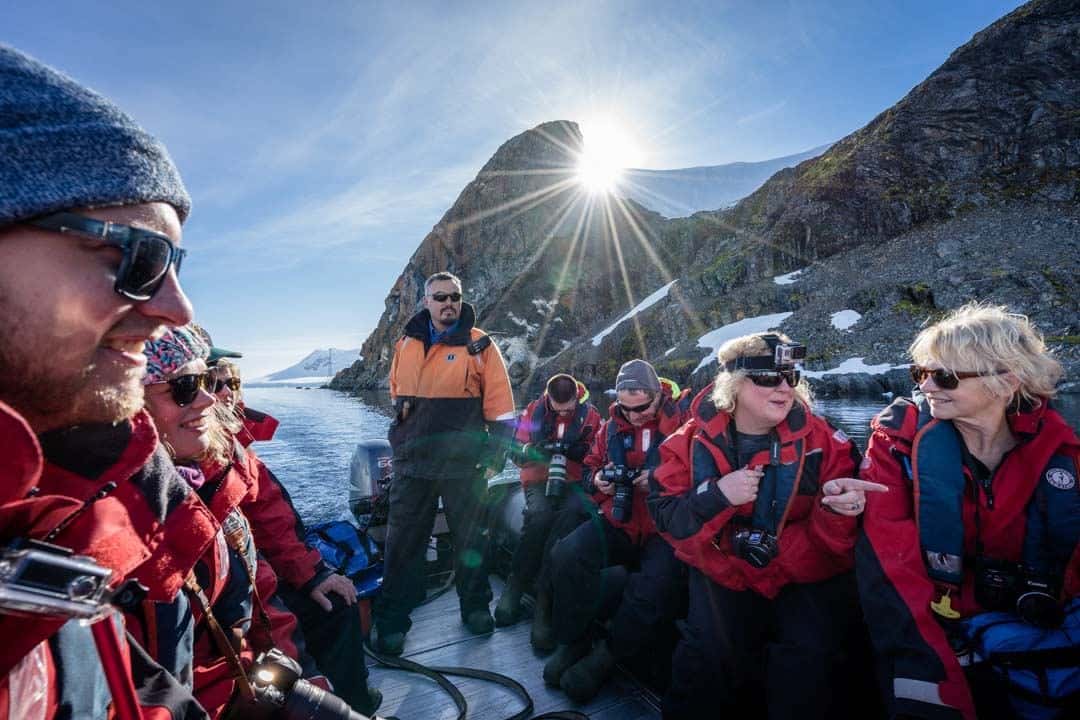
Our Best Tip For Cold-Weather Clothing: Layering
Before we get started we want to tell you how important it is to layer your clothes to maximise your body heat and mobility in cold-weather climates.
If you aren’t familiar with this it means rather than having one or two very thick, very warm pieces of clothing, you have a selection of thermals, shirts, fleeces and jackets that you can wear on top of each other.
The bottom layers are the base layer and then you will add other layers until you have the outer layer, which is typically waterproof pants and jacket.
The benefit of dressing in this style is that if you start to feel too hot (perhaps from hiking up a hill) you can peel one layer off at a time to maintain your body heat. Then put more clothes on as your body cools down again.
Think of yourself as an onion when considering what to wear in Antarctica – lots and lots of layers.
The Most Essential Items to Pack for Antarctica
With all the things to pack for your Antarctic adventure, double check that you have these items.
Waterproof Boots, Pants and Jackets
If you are travelling to Antarctica with Quark Expeditions they will provide you with top-of-the-line waterproof jackets (yours to keep afterwards) and boots for your journey free of charge.
If you are travelling with another operator it is worth checking to see if they include these items as well.)
As a result you do not need to add any of these items when looking at what to pack for Antarctica.
If your company does not supply these items it is worth seeing if they at least rent them out, as these kinds of items can be very expensive to buy.
If this is still not an option, we recommend going into your closest adventure clothing store and talking to the in-store experts about the best insulated, waterproof boots, jackets and pants they have available.
You definitely want to have waterproof pants, jackets and boots to be able to enjoy the excursion opportunities, such as sea kayaking!
Thermal Underwear
It’s important to layer your clothes in any cold climate, and Antarctica isn’t any different. The first consideration when looking at what to wear in Antarctica is a good quality pair of thermal underwear as your base layer.
You can buy synthetic material. But based on personal experiences having worked through ski seasons in Canada we recommend merino wool leggings and a top.
Kathmandu, followed by these guys, are the go-to brands for merino wool thermal underwear.
Comfortable Trousers Or Jeans
While you’ll be wearing technical clothing as your outer layer during the zodiac and land excursions when you’re walking around the ship the dress code is casual. Make sure you pack a pair of comfortable pants for this.
Personally we recommend a pair of jeans and a pair of lightweight hiking pants.
You can keep the jeans on for the evenings at dinner and in the bar, and the hiking pants can slip on in between the excursions and in the mornings for breakfast.
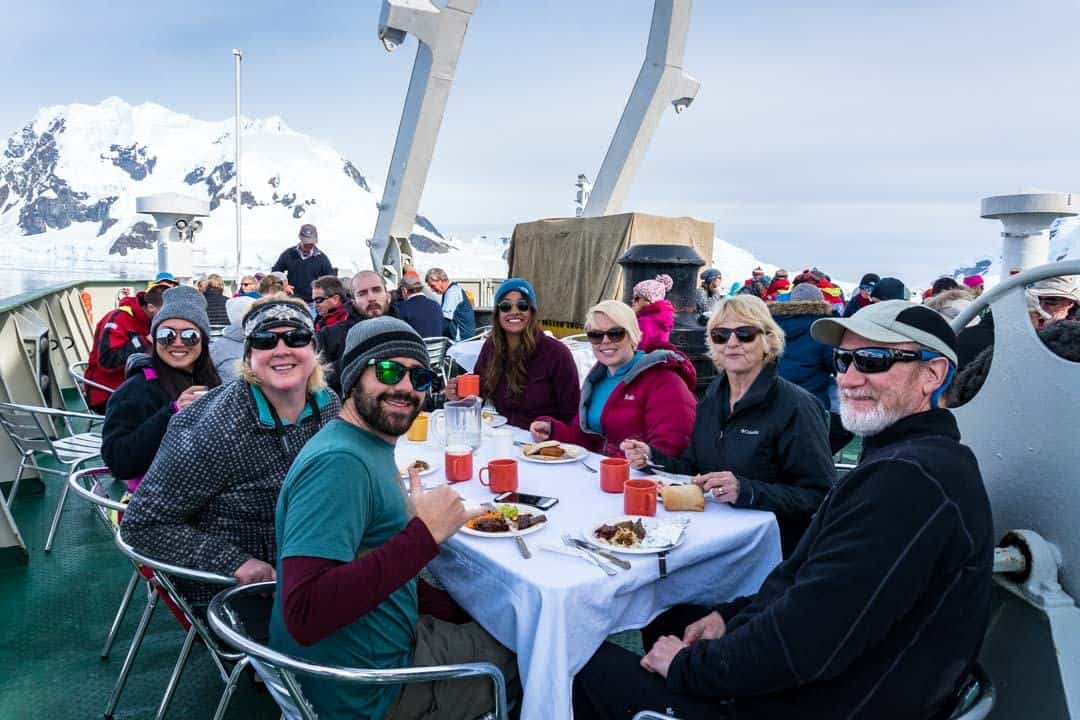
Thermal Socks x 2
The boots you are wearing a waterproof and insulated, but it’s important to layer your feet appropriately as well. One of the best things you can pick up is a pair of thin thermal socks, that act as a base layer.
Merino Wool Socks x 3
Above the base layer thermal socks, you’ll need a pair of warm socks that hug your feet properly, in order to minimise blisters. Merino wool socks are perfect for this, and they’ll add to the insulation over the top of your thermal socks.
Merino wool is also quick drying and doesn’t withhold odour, meaning you can get away with wearing them two or three times without washing them.
We recommend alternating pairs, so you wear one on one day, then hang them up overnight to air out. Wear a new pair the next day, and keep the swap up.
T-Shirts x 4
You’ll find that you’re wearing your thermal top every single day, and depending on the weather conditions outside you might get away with just throwing one t-shirt on as well before adding your outer layer.
When you’re not on land or zodiacs you’ll also be wearing your t-shirts onboard, so find some that are stylish as well as functional. Again, we recommend merino wool.
Long-Sleeve Shirt x 1
For when a t-shirt doesn’t quite suffice, make sure you pack a merino wool long-sleeve shirt as well that can be used either over your base layers or on its own for around the ship. A long sleeve shirt is a great middle-ground between having to add a layer and wearing a t-shirt.
Hooded Jumper x 1
Get yourself a lightweight, fleece jumper with a hood when buying the things you will need to pack for Antarctica. On freezing days this can accompany your base layers and be worn under your outer shell, or you can wear it around the ship.
Down Jacket x 1
Gone are the days where a down jacket would take up half your backpack and make you look like the Stay Puff Marshmellow Man.
Now companies like Kathmandu are making warm, wind-resistant down jackets that pack into their own pockets and weigh less than half a kilo.
Bring a down jacket with you for additional warmth in cold climates.
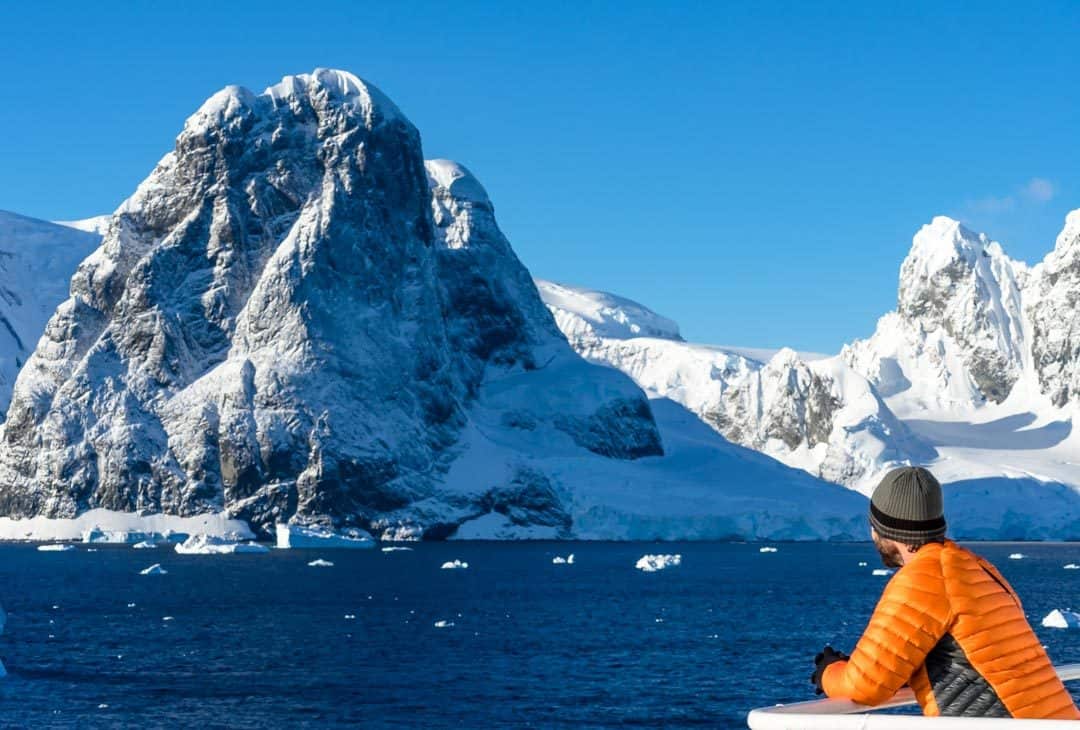
Wind/Rain Jacket x 1 (Optional)
Even though you’ll be given a waterproof, insulated jacket for the entire time you are on board, it can be a good idea to have a wind/rain jacket with you.
This is especially true if you are planning on spending any time in Ushuaia or Punta Arenas before or after your trip.
In fact, the day we set sail from Ushuaia there was a huge storm. And while where we were picked up from in town and dropped off at the port, we still had to walk through the rain to get onto the ship.
It’s highly recommended to always travel with one of these no matter what.
We use a Kathmandu NGX jacket, but you can find a whole selection of jackets on Amazon. Remember, you get what you pay for.
Glove Liners x 1 Pair
Because gloves are such a personal thing these aren’t usually supplied by the tour operators heading to Antarctica. Again with most things, we recommend layering, and that’s where glove liners come in handy.
Put these on under your big gloves as a base layer so that when you take the outer layer off (to take photos, adjust your gear, etc), you will still have a thin layer to protect your hands from the wind and cold.
Ski Gloves x 1 Pair
When it comes to choosing the best gloves for Antarctica, good ski gloves still reign supreme.
You can make a choice between mittens or fingered gloves, but personally, we recommend fingered gloves so you have extra mobility when getting on and off the zodiacs and working your equipment.
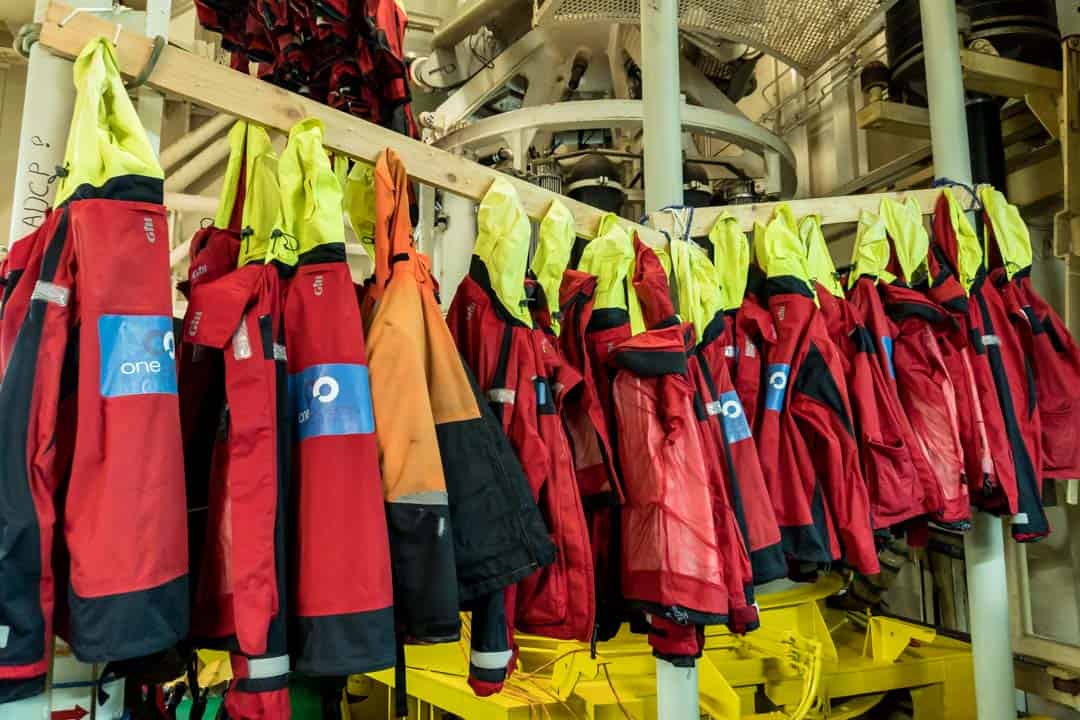
Buff Bandana/Neck Gaiter x 2
The sun shines brightly in Antarctica, and the wind has a bite to it, so you need to protect your fact from the elements. It’s all too easy to get sunburnt, even if you wear sunscreen, and the wind can dry your face, making it peel and crack.
Pick up two neck gaiters that can be worn around your neck, and pulled up over your face when out in the weather.
Buff is our favourite brand for these. Check out their Polar range.
Beanie x 1
Keeping your hear warm is one of the most important things you can do in any cold climate, so make sure you travel with a high quality and thick beanie (toque for you Canadians out there).
Sunglasses x 1
Even if you don’t normally wear sunglasses back home, in a place as white and bright as Antarctica you absolutely need them.
That being said, leave behind your fancy, expensive Ray-Bans and get something that is durable. Chances are you will bend, scratch and potentially break your sunnies if they are flimsy.
By far the best sunglasses for Antarctica are a pair of SunGods. These are ‘adventure proof’ sunglasses, meaning they are scratch-resistant and almost impossible to break under normal circumstances.
We used our pairs there without incident, while quite a few people on our expedition ended up having to throw their other branded pairs in the bin.
SunGod also come with a lifetime breakage warranty, so even if something does go wrong you can send it back and get a new pair.
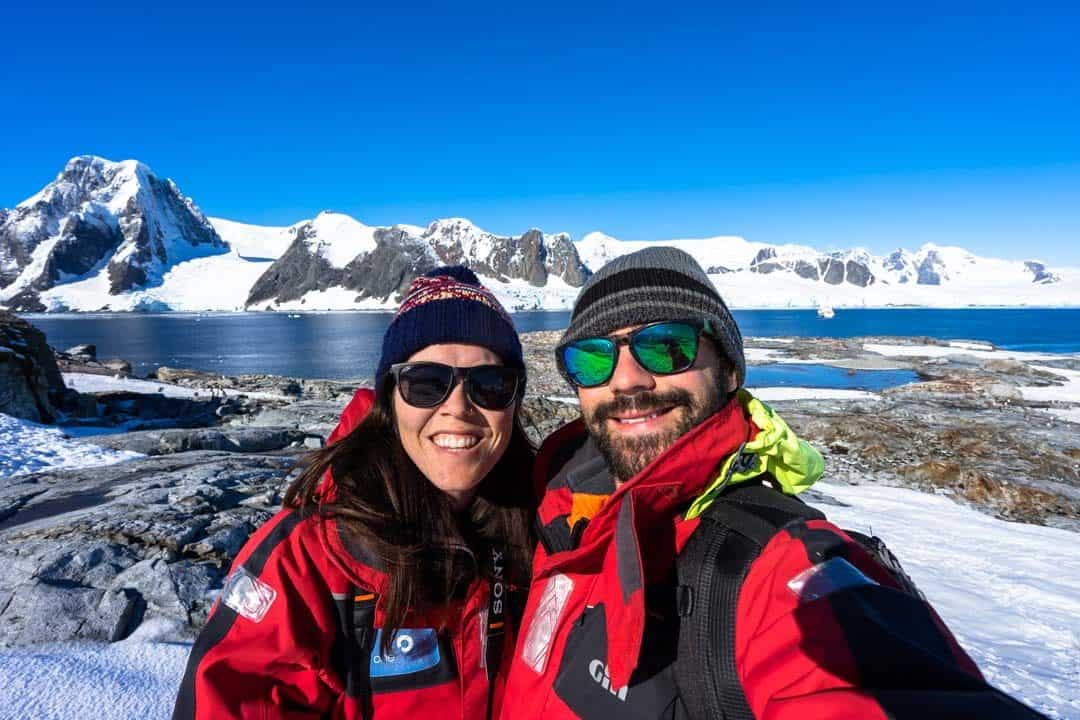
What Electronics To Pack For Antarctica
Chances are your trip to Antarctica will be a once-in-a-lifetime opportunity, and something you will never get to do again.
It is also one of the most beautiful places on earth, with a remarkable variety of wildlife that is on par with the Galapagos Islands or an African safari.
For this very reason you’re going to want to capture amazing vacation snaps.
Even if you are a beginner photographer, have no fear – Antarctica is the kind of place that is hard to take a bad photo. But to make things even better, Quark Expeditions also employ a professional photographer to accompany every single voyage, and they can help you hone your skills.
READ MORE: Want more photography tips? Check out our travel photography tips for beginners article.
Best Camera For Antarctica
This completely depends on your budget, but if you don’t already have a camera set up you are going to want to invest in a mirrorless or DSLR camera.
If you don’t want to spend thousands of dollars, we recommend the Sony A6300 mirrorless camera. It is small with incredible image quality, and shoots 4K video. It also accepts a variety of lenses.
Our personal favourite camera is the Sony A7Rii, which is a professional, 42 megapixel, full-frame mirrorless camera.
Another classic option is the Canon 6D, or you could go for the top-of-the-line 5D IV, and Canon has a huge variety of lenses available.
READ MORE: Don’t miss our complete guide to the best cameras for travel.
Wide Angle Lens
To capture those epic landscapes and insane icebergs, take a wide angle lens. A 16-35mm (for full frame cameras) is perfect, or a 10-18mm (for APS-C cameras like the A6300).
Zoom Lens
You are going to take a lot of photos of penguins and seals…trust us. And because you can’t always get right up next to them you’ll need a zoom lens.
We recommend a 70-200 at the very least. If you can afford (or rent) a 150-600 that would be even better.
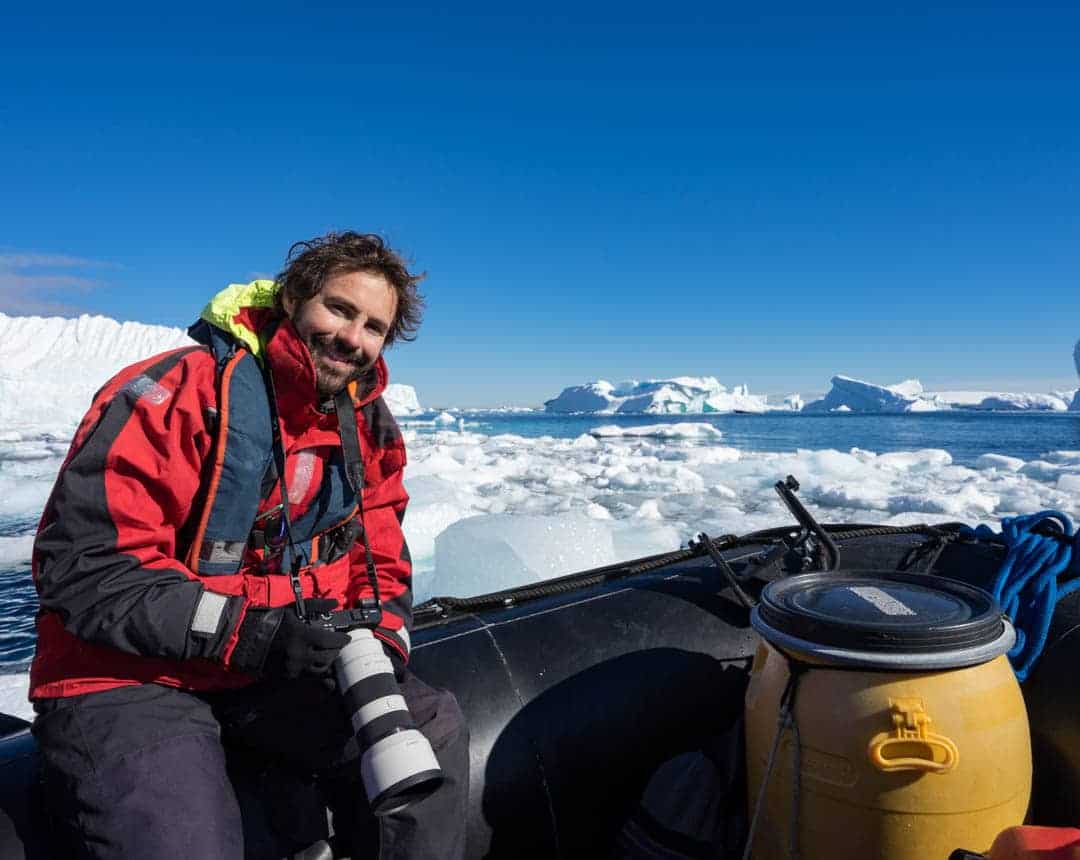
Point-And-Shoot Camera (Optional)
Accidents happen in the field, and it would be an absolute shame to have only one camera with you and break it or have something fail on it. That’s why for a place as amazing as Antarctica we recommend having a back-up camera.
For us we had the Sony A6300 as our main back-up camera, but picking up a point-and-shoot will be fine. Our favourite is the Sony RX100V, or if you want something with lots of zoom get the Sony HX80.
GoPro
GoPros are one of the most popular cameras on the market, and it’s not a gimmick – They are amazing action cameras.
The weather can change quickly in Antarctica, and if it starts snowing heavily or you are in a zodiac getting splashed you won’t want to pull out your expensive camera and risk it getting damaged.
Having a GoPro in these circumstances will help you capture shots in any kind of situation.
If you’re kayaking in Antarctica a GoPro is a much safer bet than taking your good camera too (make sure you buy a floaty backdoor for it). And if you’re a selfie kind of person, nothing beats getting a selfie on a GoPro surrounded by dozens of curious penguins!
We recommend the GoPro HERO12.
READ MORE: Want to take awesome GoPro photos? Check out our friend Calumn’s article on how to improve your GoPro photography, and our GoPro HERO12 Review can be read here.
Tripod
Tripods are essential to take sharp landscape photos, steady video or long exposure shots. We didn’t know if we’d have much time to use our tripods in Antarctica, but we found ourselves using them almost every excursion.
With Quark Expeditions the land excursions are quite relaxed, meaning you have plenty of time to set your tripod up and really focus on getting a great shot.
If you’re a serious photographer you’ll already have your favourite tripod at home, but if you’re new to the game we recommend picking up a lightweight model like the Manfrotto BeFree CF.
Another alternative is to pick up a Joby GorillaPod, which are very versatile.
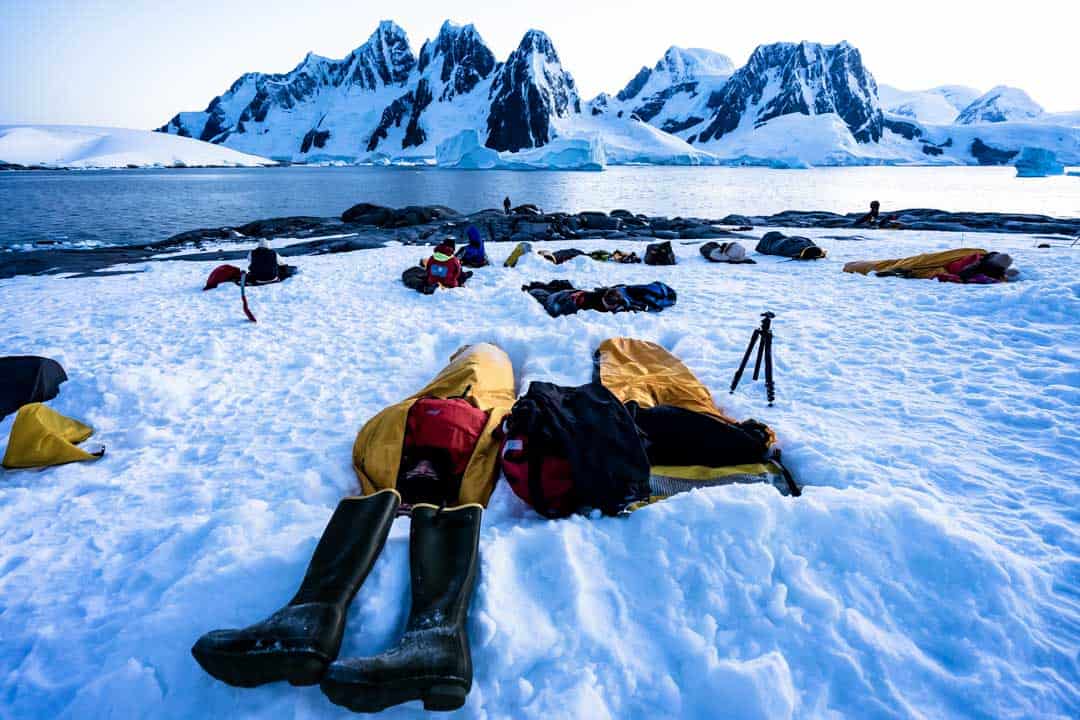
Smart Phone
Make sure you bring your smart phone with you on this trip, and always have it in your pocket.
You won’t have service in Antarctica, but being able to take notes from the scientists when they tell you something interesting or capture a quick photo when you’ve left your good camera in your cabin is essential.
Spare Batteries x 4 (Minimum)
Take as many spare batteries as you can afford, and make sure you get a multi-battery charging port.
You will be taking thousands of photos in Antarctica, and you will likely chew through batteries faster than anywhere else you have been in your life.
Remember our favourite ABC of travel as well – Always Be Charging. When you get back from your excursions immediately put your flat batteries on charge in your cabin, and swap them out for fresh ones.
Nothing would be more frustrating than having a whale breach right in front of your zodiac and your battery dies before you get your shot.
Spare SD Cards x 4 (Minimum)
We took 14 SD cards with us between all our cameras, but this is excessive for the average person. Still we recommend having at least 4 SD cards with you so you can quickly swap out when one fills up.
If your camera can handle it, pick up some 64GB SD cards with a high transfer rate.
We also highly recommend having a portable hard drive with you so you can back up all your photos every day, and clear the cards.
READ MORE: Want to know what else to bring? Check out our guide to the best camera accessories for travel.
Binoculars
If you’re interested in birdlife in particular, it’s worth picking up your own pair to take with you to Antarctica.
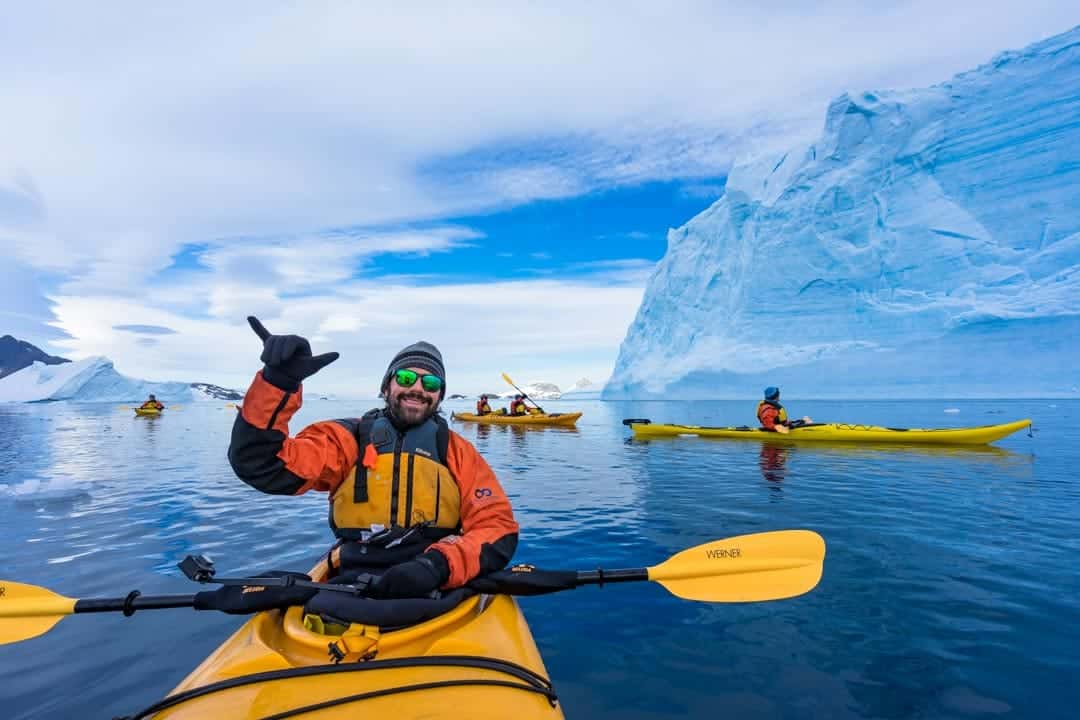
Laptop (Optional)
It is handy having your own laptop when you travel, and we recommend bringing one, especially to backup photos to clear your SD cards and edit them on the go if you’d like.
We use Apple Macbook Pros, but if all you want to do is back up your pictures at the end of the day any laptop will do.
Day Pack
When you do your land and zodiac excursions you’ll need something to carry your camera gear in, and perhaps an extra layer in case the weather changes.
If you’re carrying a lot of camera equipment like us you’ll want a large, dedicated camera bag. Otherwise any daypack will do that you can stick a few things in.
You may also be interested in: Our buyer’s guide on the best packable day packs.
Waterproof Cases For Electronics
These can vary from Lifeproof cases for your smart phone to plastic, ziplock sleeves right up to waterproof plastic cases to keep your cameras in.
No matter what you choose, at least bring something that you can stick your electronics in to protect them from the rain, snow and waves.
Heavy duty dry bags are a good option. If you are sea kayaking you will be given one of these by the crew at Quark Expeditions. Otherwise bring your own that is big enough to put your expensive cameras in.
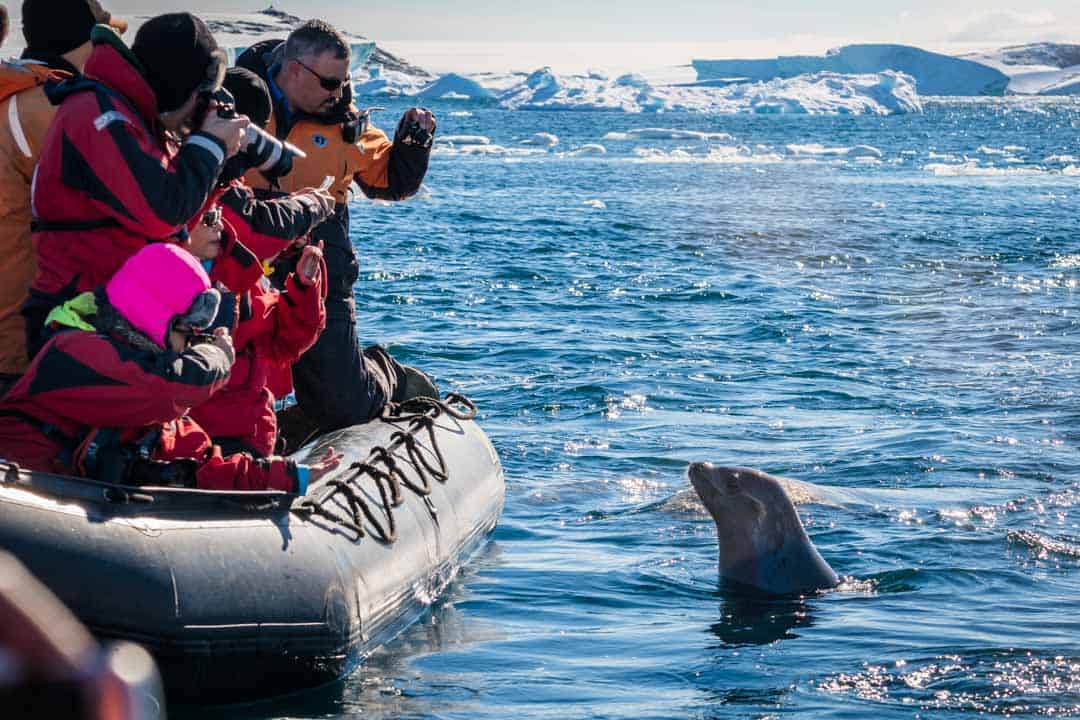
Suitcase vs Backpack – Best Luggage For Antarctica
This really doesn’t matter, because once you are onboard the ship you will unpack your bags into your cabin and the crew will take your luggage away for storage. You won’t need these again until you disembark.
You will, however, need a daypack or camera bag though.
DISCLAIMER: Some of the links in this article are affiliate links, which means if you book accommodation, tours or buy a product, we will receive a small commission at no extra cost to you. These commissions help us keep creating more free travel content to help people plan their holidays and adventures. We only recommend the best accommodations, tours and products that ourselves or our fantastic editorial team have personally experienced, and regularly review these. Thanks for your support, kind friend!


3 thoughts on “What to Wear in Antarctica – Ultimate Travel Packing List”
Hey, guess what?! We just accomplished something truly amazing – we have now set foot on all 7 continents, including the remote and challenging land of Antarctica!
According to the International Association of Antarctica Tour Operators (IAATO), there have been only around 750,000 people who have ever stepped foot on Antarctica, and we are now part of that exclusive group!
But what’s even more mind-blowing is the fact that less than 500,000 people in the entire history of humanity have ever visited all 7 continents. That’s less than 0.5% of the estimated 107 billion people who have ever lived on Earth! It’s truly an incredible feat that we can hardly wrap our heads around.
We feel so grateful and privileged to have been able to experience all the incredible wonders that each continent has to offer – from the vast deserts of Africa to the lush rainforests of South America, and everything in between.
And we want to give a shout-out to Gregg McKeown and Ann Estrada from Saddle Brook, NJ, who are also part of this exclusive club of 7-continent explorers. We know firsthand just how incredible this achievement is, and we’re thrilled to share it with such amazing company.
Here’s to more adventures, more discovery, and more wonder in this beautiful world of ours!
My husband and I are in our 80’s. We are in good condition, but are beginning to wonder (since reading more about going to Antarctica) if this was a good choice for our cruise. We have booked with Seabourn Cruise Line. We are excited about experiencing the beauty of Antarctica and love adventure, but now have some doubts about how we will fare. We cannot cancel the trip without losing our money — which is considerable. Do you have any suggestions for us? Do you know of others in our age group who have made this trip? Thank you.
Hi Glennda,
You will have a fabulous time with Seabourn. We went on the Seabourn Sojurn in June to Alaska and the trip was amazing. Fantastic ship and crew. We had a lovely disabled lady on our cruise (she had one leg)and she was helped from her wheel chair onto the Zodiacs. The adventure staff will be able to reassure you so chat to them.
We are going to Antarctica late November on the Scenic Eclipse and Im also a bit nervous ( we are in our late 50’s). We booked this trip before cruising with Seabourn but will definitely cruise with Seabourn again. (The food is amazing!!!)
You will have a ball. This Nomadasaurus site has been great for packing ideas (there sunglasses they recommended are awesome) and after reading some of their adventures, I am very excited.
Good luck and enjoy the trip of a lifetime. Andrea